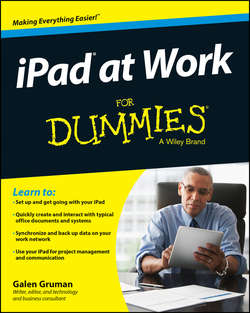Читать книгу iPad at Work For Dummies - Galen Gruman - Страница 12
На сайте Литреса книга снята с продажи.
Part I
Getting Started with iPad at Work
Chapter 3
Ensuring Your iPad’s Security
Working with Mobile Device Management
ОглавлениеAs mentioned in the preceding section, one method for separating business and professional information is to use a mobile device management server, a.k.a. MDM and EMM (for enterprise mobility management). These are systems that your IT department has to deploy and manage, usually for a monthly per-user fee, so they tend to be something that only larger companies use.
But even a small company can use some of these services, thanks to cloud-based small-business versions.
Popular providers include BlackBerry, CA Technologies, Citrix Systems, Good Technology, IBM, MobileIron, SAP, and Soti, though dozens of providers are out there.
An MDM server does at least two things:
✔ Manages user devices like iPads, such as by imposing restrictions on what networks you can access, determining what apps you can install, blocking access to iTunes and iCloud, and controlling whether you can open mail attachments in other apps. They can also remotely lock or wipe your device, disable access to corporate systems, and configure the use of virtual private networks (VPNs, described in the next section).
✔ Provide safe “containers” for corporate apps and data. Typically, these services provide their own apps for handling email, contacts, and calendars, and perhaps other functions. They’re kept in a separate part of the iPad’s memory known as a container that serves as a partition from the rest of your iPad’s apps and data. These apps can access corporate servers for documents and other data, but they can’t share that information with other apps on your iPad. These apps may also include a storage container for documents that you can browse, open from, and save to as well.
As a user, you’re restricted to what your IT department has decided it will permit via MDM. If those restrictions are too onerous, all I can recommend is that you don’t use a personal iPad for work but instead require your company to provide you with an alternative tool for business needs, such as a separate iPad or a laptop.
Enforcing basic security without the cost or effort of an MDM server
The iPad natively supports the Exchange ActiveSync (EAS) management policies provided by Microsoft’s popular Exchange server (including the Office 365 service). It’s sort of a budget MDM for small businesses, letting the company require your iPad be protected with a password (including its complexity and how often it must be changed), wipe or lock your device remotely, and remotely configure some security settings such as for Wi-Fi access points and VPNs.
The Exchange or Office 365 administrator for your company sets up which policies apply to which user groups in the management console for Exchange or Office 365.
I encourage any company of any size to at least use these policies to set basic security parameters for users’ iPads. You may not need a full-blown MDM tool, but everyone should set up basics such as password requirements.
Apple has another MDM option on the cheap – two, actually. But they’re Mac-only products. One is the free Apple Configurator (available at the Mac App Store), which lets you set policies similar to what EAS offers as well as impose additional restrictions and apply additional configurations. You create profiles in the application and configure the settings, called payloads, that you want included. Figure 3-6 shows the payload for passwords.
Figure 3-6: Setting up a configuration file in Apple Configurator on the Mac.
You then connect devices to the Mac running Apple Configurator and click Install Profiles in the Prepare pane to select the attached devices to install the profiles to.
Supervised mode resets the iPad and then applies all the settings to it, so it should be used only for new iPads that IT will continue to manage. Be sure to back up the iPad to iTunes, as described in Chapter 2, before resetting the iPad this way. Furthermore, only the Mac that was initially used to supervise the iPad can apply changes to the configuration changes in the future.
Then there’s the $20 OS X Server application (available from the Mac App Store), which lets you remotely apply the same policies and configurations as the Apple Configuration Utility to Macs and iOS devices does. It works like the Apple Configurator, except that it ties into your company’s user directory, which requires some IT administrator expertise to use.
Both the OS X Server and an MDM tool can create configuration files that set up various security and management settings so that users don’t have to do the manual work – and so that IT can ensure that everyone has the correct settings. If you access those configuration files via links on web pages, through OS X Server’s remote delivery feature, or as email attachments, you’ll have to confirm the installation of the configuration file on your iPad, as Figure 3-7 shows.
Figure 3-7: A configuration file has to be accepted by the user to be installed.
To accept a configuration profile, you may need to disable Find My iPad temporarily. Do so in the iCloud screen of the Settings app. (I explain Find My iPad later in this chapter.)
Configuration files can be managed in the Settings app. Go to the bottom of the General pane and tap Profile to see a list of installed configurations. Tap a profile to get more details on it, as well as to get to the Delete Profile button. (But note that configuration files can be made undeletable by the user, so not all profiles will offer the Delete Profile button.)
